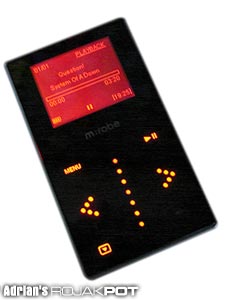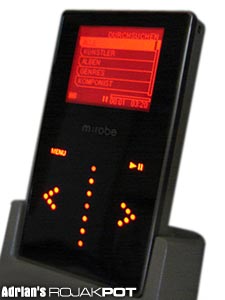Controls
Unlike other manufacturers who try to duplicate Apple's successful click-wheel UI (user interface), Olympus decided to go with touch-sensitive controls both for navigation and playback. Located beneath the front glass cover, they are activated when you touch a specific area. There's no difference in functionality, except that there are no moving parts, so it should be more reliable than mechanical interfaces.
It's also fun to play around with such controls. Believe me, it's like a sci-fi experience! The central line of dots is the vertical navigation strip which allows you to scroll through any list on the screen or the player's settings using your thumb. You can tap and hold either end of the strip to scroll continuously.
Sadly, you cannot adjust the strip's sensitivity, so you can't do anything if you feel it's too sensitive or not sensitive enough. But even though the controls lie behind a sheet of glass, the navigation strip is satisfactorily sensitive. There should not be any reason to complain about its sensitivity.
Aside this navigation strip, there are touch controls for "Menu" (which switches you to the Menu and back), "Play/Pause", "Next" (also serves as a fast forward control), "Back" and "Playlist" (for switching between the display of the current song, its lyrics and the playlist).
The Display Screen
The player comes with a monochrome LCD with very good contrast and a decent resolution. Unlike many players, it uses an inverted display, with light letters or graphics on a dark background. When the backlight is turned on, the background becomes dark red in colour.
You can set the backlight to time-out after a certain duration or turn it off completely. However, this is not recommended because reading the text is quite hard without it. You really need the backlight.
Some might say that using a monochrome LCD these days is a step backwards. But let's keep in mind that it actually completes the MR-100's distinctive design. It's the perfect accompaniment to the player's black facade. A coloured LCD would be truly out of place.
Codec & Tag Support
The MR-100's codec support is something some people will gape at and that would be quite understandable. The player only supports MP3 and WMA.. that's it. No other codecs are supported.
It doesn't support gapless MP3 playback either. Then again, there isn't any other mini audio player in the market that can do that so far.
The music stored in the player is organized using iD3 tag data. So, you can sort them by artist, album, track, genre, composer or year of release. But there's no way to navigate through the actual file system because you are not allowed to see them, Nor can you delete music from the player directly. To do that, you need to use the m:trip software.
While the player supports long filenames, it's unfortunate to note that the player cannot display the full filename, either by showing it as a marquee or splitting it into two or more lines. The filename gets rudely truncated if it cannot fit within the display column.
m:trip
The most iffy part of the player is probably the m:trip software. Of course, it's always desirable for the player to be able to function completely independent of any desktop software. But if it requires a software, let it please be a decent piece of software. Unfortunately, m:trip is anything but decent.
It's not the installation which was smooth and proceeded without any problem. It's also not about its feature-set. It's slick, and packed with features like a music library manager, playlist editor, iD3-tagger, music ripper, EQ + visuals and so on.
It's also quite user-friendly, well, except for the lack of a simple drag and drop synchronization feature. No, it's none of those things. There are just two things about m:trip that are really a big headache.
- It's an absolute necessity!
Olympus designed the player so that m:trip is absolutely required to transfer files from desktop to player and vice versa. Without it, the MR-100 won't be able to recognize or play them. Of course, you can drag and drop tracks using Windows Explorer but the player still won't recognize them at all.
- It only works with one computer!
m:trip will only work with the computer in which you installed it and synchronized with m:trip for the first time. This is probably due to DRM requirements. But whatever the reasons, you cannot synchronize the player with music files from any other computers, even if you install m:trip in those computers.
Apart of those limitations, Olympus did a respectable job with m:trip.







 Add to Reddit
Add to Reddit




